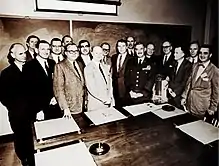Fritz Mueller
Fritz K. Mueller (1907 – 2001 Huntsville, Alabama, USA) was a German engineer.

Mueller was hired by Kreiselgeräte Company in 1933.[1] He developed the PIGA accelerometer.[2] and worked on gyroscopes for Nazi Germany's Kriegsmarine. Later on, he worked on the guidance and control system for the A3 test rocket, the A5, and the A4 (V-2) ballistic missile.[3]
Under Project Paperclip, Mueller emigrated to the United States on 16 November 1945 with the Argentina group. There, he worked on developing guidance systems for the PGM-11 Redstone, PGM-19 Jupiter, MGM-31 Pershing, and the Saturn I missiles.[4] In 1960 Mueller left NASA for private industry.[5]
References
- Donald A. MacKenzie (1993). Inventing accuracy: a historical sociology of nuclear missile guidance. MIT Press. p. 59. ISBN 978-0-262-63147-1.
fritz mueller guidance.
- "The Myth of V2 Inaccuracy and Ineffectiveness". newsgroups.derkeiler.com. Retrieved 31 December 2015.
- Roger E. Bilstein (1999). Stages to Saturn: A Technological History of the Apollo/Saturn Launch Vehicle. DIANE Publishing. p. 243. ISBN 978-0-7881-8186-3.
fritz mueller guidance.
- Michael J. Neufeld (2008). Von Braun: Dreamer of Space, Engineer of War. Random House, Inc. ISBN 978-0-307-38937-4.
- "Mueller, Fritz". Encyclopedia Astronautica. Archived from the original on 12 September 2010. Retrieved 31 December 2015.
External links
This article is issued from Wikipedia. The text is licensed under Creative Commons - Attribution - Sharealike. Additional terms may apply for the media files.
